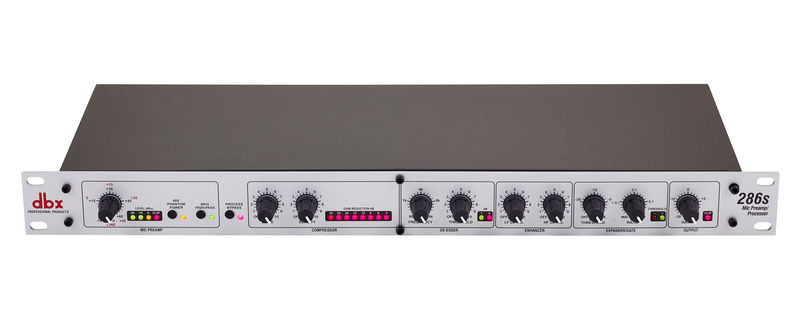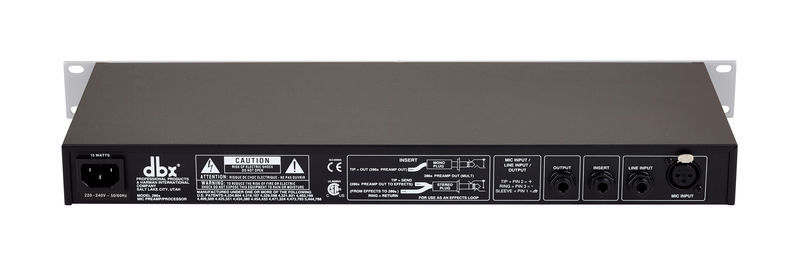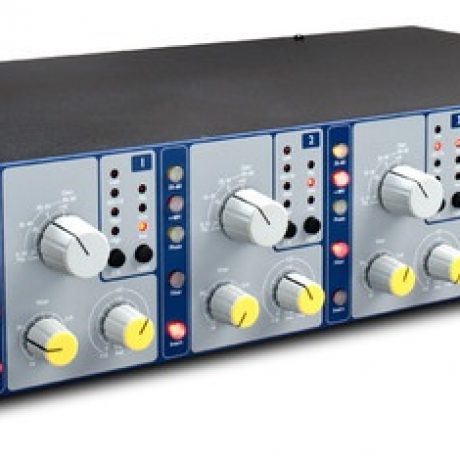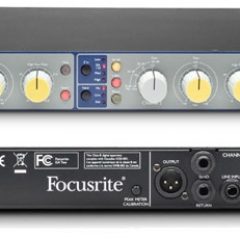| Content | The dbx® 286s is a full featured Channel Strip Processor that delivers a studio quality microphone/instrument preamplifier and four processors that can be used independently or in any combination. Why mic up vocals and instruments through a noisy, blurry mixer? The sonically pristine dbx 286s Mic Preamp has all the features you need, including wide-ranging input gain control, switchable +48V phantom power, and an 80Hz high-pass filter to remove low frequency hum, rumble or wind. Use the patented dbx OverEasy® compressor to transparently smooth out uneven acoustic tracks or deliver that classic "in your face" vocal performance that only a dbx compressor can. Eliminate vocal sibilance and high frequency distortion from instruments such as cymbals with the frequency tunable De-Esser. Fine-tune the Enhancer HF Detail control to add sparkle and crispness to your tracks and make adjustments to the LF Detail control to add fullness and depth to vocals and bass instruments while cleaning up the muddy low midrange frequencies. And, the separate threshold and ratio controls on the Expander/Gate allow you to subtly reduce headphone leakage or radically gate noisy guitar amps.
The dbx 286s offers a full compliment of metering and status LEDs to visually guide you to achieving the right sound. The floating balanced XLR Mic Input accepts balanced or unbalanced inputs to easily connect to professional and home studio microphones. The additional 1/4" TRS Line Input can accept balanced/unbalanced signals to process live electronic instruments or pre-recorded tracks at mixdown. Use the Insert jack to interface between the Mic Preamp and the signal processing sections to "loop out" to external processors (such as EQ or delay unit) or to mix the Mic Preamp's signal out to an external destination.
The cost and hassle of patching together multiple processors for use on one track can be frustrating. The dbx 286s provides you with all the mic processing you need in one box, with the shortest, cleanest signal path to keep your music sounding its best!
- Studio quality Mic Preamp/Channel Strip Processor
- Classic dbx Compression puts great sound within easy reach
- Frequency tunable De-Esser reduces sibilance and high frequency distortion
- Enhancer increases the detail and definition of the high and low frequencies
- Program adaptive Expander/Gate
- Insert jack allows you to add an external processor
- Full compliment of meters and status LEDs
- +48V Phantom Power
- Precision detented controls
| Mic Preamp Connector |
XLR Floating balanced, Pin 2 Hot |
| Mic Preamp Input Impedance |
~4.2kΩ |
| Mic Preamp gain |
0dB to +60dB |
| Mic Preamp Phantom Power |
+48VDC, applied to XLR pins 2 and 3 through 6.81kΩ resistors |
| CMRR |
>40dB, typically 55dB |
| Mic Preamp max input level |
0.2Vrms, Gain = 30dB |
| Mic Preamp Equivalent Input Noise (EIN) |
-125dBu, 22Hz-22kHz, 150Ω source impedance |
| Input Connectors |
(line) Floating balanced, TIP Hot |
| Input Impedance |
(line) 10kΩ unbalanced, 20kΩ balanced |
| Max Input |
(line) >+21dBu, balanced or unbalanced |
| Input Gain Range |
(line) -15dB to +45 dB |
| Insert Connector |
1/4" TRS: Normalled; tip is Send, ring is Return |
| Insert Impedance |
>5kΩ (ring-return); 100Ω (tip-send) |
| Insert Max Level |
>+21dBu; >+20dBm (600Ω load-tip) |
| Insert Noise |
|
|
Two channel classic Focusrite ISA transformer-based preamps Front panel, per channel: - 1/4" instrument input
- Variable input impedance - Low, ISA 110, Medium, High
- Input selection - Mic, Line, Instrument
- 0 - 30 dB/30 - 60 dB gain switch
- Phantom power switch
- Phase invert switch
- 0 - 60 dB gain in 10 dB steps
- 0 - +20 dB continuously variable trim
- Variable high-pass filter with on/off switch
- Insert point on/off switch
- Eight-LED user-calibrated level meters
- Single power switch
Rear panel, per channel: - XLR-F mic inputs
- 1/4" TRS line inputs
- 1/4" TRS Sends
- 1/4" TRS Returns
- XLR-M line output
- Single peak meter calibration dial
- Single IEC power socket
Measured Performance | Maximum Input and Output Levels | | Maximum Output Level |
+24 dBu with a THD+N
| | Maximum Microphone Transformer Input Level | +7 dBu with a THD+N | | Mic Input Response | | Gain range | 0 dB to +60 dB in 10 dB steps, plus 0 dB to +20 dB continuously variable trim | |
Input Impedance
| Switched Impedance setting
Equivalent Input Impedance at 1 kHz | Low = 600 Ω
ISA 110 = 1.4 kΩ
Med = 2.4 kΩ
High = 6.8 kΩ | EIN
(Equivalent Input Noise) | Measured at 60 dB of gain with 150 Ω
source impedance and 22 Hz-22 kHz band pass filter | -127 dB | |
Noise
| Noise at output with unity gain (0 dB) and 22 Hz-22 kHz band pass filter | -97 dBu | |
Signal-to-Noise Ratio
| Measured with 150 Ω source impedance and 22 Hz-22 kHz band pass filter | 121 dB relative to max output +24 dBu | |
Total Harmonic Distortion + Noise
| Measured with a -20 dBu input signal at +30 dB of gain and with a 22 Hz-22 kHz band pass filter |
| |
Frequency Response
| At minimum gain (0 dB) |
-0.5 dB at 10 Hz,
-1 dB at 135 kHz, relative to 1 kHz
| |
At +60 dB gain
| -6 dB at 10 Hz,
-1 dB at 115 kHz, relative to 1 kHz | |
CMRR (Common Mode Rejection Ratio)
| -94 dB for mic input at 60 Hz for max. output = +24 dBu
-91 dB for mic input at 10 kHz for max. output = +24 dBu | |
Crosstalk Channel to Channel
| Mic input, with I/P = 0 dBu, gain = 0 dB @ 1 kHz input to channel A, channel B output = -85 dB | | Line Input Response | |
Gain Range
| -20 dB to +10 dB in 10 dB steps, plus 0 dB to +20 dB continuously variable trim | |
Input Impedance
| 10 kΩ from 10 Hz to 200 kHz | |
Noise
| Noise at main output with gain at unity (0 dB) measured with 50 Ω source impedance and a 22Hz - 22 kHz band pass filter |
-97 dBu
| |
Signal-to-Noise Ratio
| Measured with 50 Ω source impedance and a 22 Hz-22 kHz band pass filter |
121 dB relative to max output +24 dBu
| |
Total Harmonic Distortion + Noise
| Measured with a 0 dBu input signal, +10 dB of gain and a 22 Hz-22 kHz band pass filter |
| |
Frequency Response
| At unity gain (0 dB) | -0.3 dB at 10 Hz,
-1 dB at 80 kHz, relative to 1 kHz | |
Crosstalk Channel to Channel
| Line input, with I/P = 0 dBu, gain = 0dB
@ 1 kHz input to channel A |
Channel B output
= -91 dB
| | Instrument Input Response | |
Gain Range
| +10 dB to +40 dB continuously variable trim | |
Input Impedance
| > 2 MΩ | |
Noise
| >Measured with 22 Hz-22 kHz band pass filter | Minimum gain (+10 dB) = -95 dBu | |
Frequency Response
| At minimum gain (+10 dB) |
-0.1 dB at 10 Hz,
-1 dB at 115 kHz, relative to 1 kHz
| |
At maximum gain (+40 dB)
|
-2.5 dB at 10 Hz,
-1 dB at 110 kHz, relative to 1 kHz
| | High-Pass Filter | |
Roll-Off
| 18 dB per octave (3 pole filter) | |
Frequency Range
| Continuously variable from 16 Hz to 420 Hz (-3 dB) | | Weight and Dimensions | |
W x D x H
| 480 mm x 280 mm x 44 mm | |
Weight
| 3.7 kg |
|
At PreSonus, weʼve been designing preamps for a long time, and we always focus on audio quality first. So when we decided to upgrade our popular TubePre V2, we focused on improving an already high-quality sound—without jacking up the price. Like the originalTubePre, the new version is a fully professional tube preamp, with a dual-servo (no capacitors) gain stage that lets you boost the program signal to smoking hot levels without significantly increasing the background noise. Discrete components and high-voltage operation offer dynamic range and detail not found in other single-channel tube preamps in its class.
Housed in a rugged case, the TubePre V2 rear panel sports separate unbalanced, ¼” instrument and balanced, XLR mic inputs and unbalanced ¼” and balanced XLR line outputs. Weʼve included all of the extras you need for professional operation including a high-pass filter, phantom power for condenser mics, polarity reverse switch, and a backlit VU meter.
|
- 1 microphone, XLR (bal.) or 6.3 mm jack (unbal.)
- Gain control, 10 steps (6-50 dB)
- Phantom power can be switched on
- Clip LED
- 1 line output, XLR (bal.) or 6.3 mm (unbal.)
- Operation via supplied power unit
| Power supply: | 12 V DC, 150 mA | | Input impedance: | 10 kohms bal./unbal. | | Max. input level: | +4 dB bal./+10 dB unbal. | | Gain: | 50 dB XLR/44 dB jack | | T.H.D.: | 0.01 % | | Frequency range: | 25 Hz - 16 kHz | | S/N ratio: | >75 dB | | Dimensions: | 143 x 93 x 45 mm | | Weight: | 350 g |
|
Mic Inputs
• Frequency response at minimum gain (0dB): -0.35dB at 20Hz and –3dB at 122kHz
• Frequency response at maximum gain (60dB): –2.5dB at 20Hz and –3dB 103kHz
• Gain range: 0dB to +60dB in 10dB steps, plus 0dB to +20dB continuously variable trim
• Maximum headroom: +7.4dBu
• THD+N: 0.0009% (measured at 1kHz -20dBu input signal, at 30dB gain setting, with a 20Hz/22kHz bandpass filter)
• Noise EIN: -126dB (measured at 60dB of gain with 150Ω termination and 20Hz/22kHz bandpass filter)
• Noise at main output with unity gain: -98dBu (measured with a 20Hz/22kHz bandpass filter)
• SNR: 123dB (relative to max output 25dBu)
• SNR: 120dB (relative to 0dBFS (+22dBu)
• CMRR: 88dB.
• Input Impedance, variable: 600Ω, 1400Ω, 2400Ω, 6800Ω
Line Inputs
• Frequency Response at unity gain (0dB): -0.3dB at 20Hz and –3dB at 94kHz
• Gain range: -20dB to +10dB in 10dB steps, plus 0dB to +20dB continuously variable trim
• Maximum headroom: +25.4dBu
• THD+N: 0.002% (measured with +4dBu input signal, 0dB gain setting, with a 20Hz/22kHz bandpass filter)
• Noise at main output with unity gain: -91dBu (measured with a 20Hz/22kHz bandpass filter)
• SNR: 116dB (relative to max output 25dBu)
• SNR: 113dB (relative to 0dBFS +22dBu). Input Impedance: 10kΩ
Instrument Inputs
• Frequency Response at +10dB gain: -0.2dB at 20Hz and 0dB at 200kHz
• Frequency Response at +40dB gain: -3dB at 20Hz and –3dB at 38.4kHz
• Gain range: +10dB to +40dB continuously variable
• Maximum headroom: +11.5dBu
• THD+N: 0.006% (measured with –20dBu input signal, at minimum gain (+10dB), with a 20Hz/22kHz bandpass filter)
• Noise at main output with minimum gain (+10dB): -95dBu (measured with a 20Hz/22kHz bandpass filter)
• Input Impedance = >1MΩ
High Pass Filter
• Roll off = 18dB per octave 3 pole filter
• Frequency range: 16Hz to 420Hz (continuously variable, measured at the 3dB down point)
Meters
• 6 LED meter is calibrated 0dBFS = +22dBu (the maximum level which can be correctly converted by the optional internal A/D converter before overload occurs). The meter calibration points are as follows:
Meter panel calibration value in dBFS / Equivalent dBu value
0dBFS / +22dBu
-2dBFS / +20dBu
-6dBFS / +16dBu
-12dBFS / +10dBu
-18dBFS / +4dBu
-42dBFS / -20dBu
Front and rear connectivity
Analogue Channel Inputs (Inputs 1-4)
• 4 instrument 1⁄4” TS jack inputs on front panel
• 4 microphone XLR inputs on rear panel
• 4 line 1⁄4” TRS jacks on rear panel
• 4 insert return 1⁄4” TRS jacks on rear panel
• 4 ADC XLR inputs on rear panel
Analogue Audio Outputs (Outputs 1-4)
• 4 line XLR outputs on rear panel
• 4 insert send 1⁄4” TRS jacks on rear panel
Other I/O
• IEC power input connector 100Vac – 240Vac
Front Panel Indicators
• 8 output meters, 6 segment
• 4 30-60 mic gain range selection indicator
• 4 +48V phantom power indicator
• 4 Phase indicator
• 4 Insert In indicator
• 4 Filter In indicator
• 4 Input selection indicators (Mic, Line, Inst)
• 4 Z In microphone input impedance selection indicators (Low, ISA110, Med, High) Clock select indicators (44.1, 48, 88.2, 96, 176.4, 192)
• Ext clock indicators (Lock, Word clock, 256X)
Weight
5.5kg
12.2lbs
Dimensions (W x H x D)
480mm (W) x 88mm (H) x 280mm (D)
19" (W) x 3.5" (H) x 11" (D)
| ISA OneClassic Single-channel Microphone Pre-amplifier with Independent D.I.
Key Features
ISA Series Transformer-based Pre-amplifier
Encased in a rugged and portable chassis, ISA One offers the classic Focusrite microphone pre-amplifier at its lowest cost to date.
Flexible Independent D.I. Channel
ISA One is ideal for both engineers and demanding performers alike, featuring independent gain control, an output for routing to an amp, an independent XLR output on the rear and routing to the optional ADC.
Switchable Impedance
Choose one of four carefully selected input impedances, including the original ISA 110 setting, to suit any microphone.
Optional Stereo 192kHz ADC
This optional card embodies cutting-edge conversion technology, incorporating Focusrite analogue circuitry to deliver the best A-D performance in its class (Dynamic range of 119dB).
Rugged Custom Flight Case
Built to protect your ISA One from the rigors of the road. Rugged plywood construction with a solid polypropylene exterior and reinforced corners.
Headphone Output with Volume Control
ISA One can feed either a sum of the two inputs to the headphones output, or an external stereo cue mix (such as a stereo mix feed from an interface) via two TRS Jack inputs on the rear of the unit.
Dedicated Insert Point
Allows you to place extra processing between the pre-amplifi er or D.I. and the optional converter, such as an EQ or compressor.
Specifications
Analogue Channel Inputs
- XLR Mic input
- One XLR and one TRS line input
- XLR Instrument input TRS Jack
- External ADC input TRS Jack
- TRS jack return
|
Analogue Channel Outputs
- TRS jack send
- XLR balanced line output
- XLR DI output
- TS jack DI through
|
Analogue Channel Additional I/O
- TRS Jack cue mix left input
- TRS Jack cue mix right input
- 1/4” TRS Jack headphones output
|
Mic Input Response
| Gain range |
0dB to 60dB in 10dB steps + 20 dB of variable gain |
| Input Impedance |
Switched Impedance setting Equivalent Input Impedance at 1kHz |
Low = 600 Ohms
ISA110 = 1400 Ohms
Med = 2400 Ohms
High = 6800 Ohms |
| EIN (Equivalent Input Noise) |
-126dB measured at 60dB of gain with 150 Ohm terminating impedance and 22Hz/22kHz band-pass filter |
| Noise |
Noise at output with unity gain (0 dB) and 22 Hz-22 kHz band pass filter |
-97 dBu |
| Signal-to-Noise Ratio |
106 dB relative to max headroom (9dBu) |
| Total Harmonic Distortion + Noise |
Measured at medium gain (30dB) with a 1kHz -20dBu input signal and with a 22Hz/22kHz band-pass filter |
|
| Frequency Response |
At minimum gain (0 dB) |
-0.5dB down at 10Hz and -3dB down at 125kHz |
|
At maximum gain (60dB) |
-3dB down at 16Hz and -3dB down 118kHz |
| CMRR (Common Mode Rejection Ratio) |
98dB (Channel 1, 1kHz, maximum gain with +24 dBu input) |
| Crosstalk Channel to Channel |
With 10dB@1kHz input to chA, chB output =104dBrA. With 10dB@10kHz input to chA, chB output = 84dBrA |
Line Input Response
| Gain range |
-20dB to +10dB in 10dB steps + 20 dB of variable gain |
| Input Impedance |
10 kΩ from 10 Hz to 200 kHz |
| Noise |
Noise at main output with gain at unity (0 dB) measured with 50 Ω source impedance and a 22Hz - 22 kHz band pass filter |
-96 dBu |
| Signal-to-Noise Ratio |
Measured with a 22 Hz-22 kHz band pass filter |
120 dB relative to max headroom (24 dBu)
118dB relative to 0dBFS (+22dBu) |
| Total Harmonic Distortion + Noise |
Measured with a 0 dBu input signal, and a 22 Hz-22 kHz band pass filter |
0.0001% |
| Frequency Response |
At unity gain (0 dB) |
-0.3dB down at 10Hz and -3dB down at 200kHz |
Instrument Input Response
| Gain range |
10dB to 40dB continuously variable |
| Input Impedance |
High = greater than 1M
Low =greater than 300k |
| Noise |
Measured with 22 Hz-22 kHz band pass filter |
Minimum gain (+10 dB): -92 dBu
Maximum gain (+40dB): -62dBu |
| THD |
At minimum gain (+10) |
| Frequency Response |
At minimum gain (+10 dB) |
-10dB input: 10Hz-100kHz +/- 0.6dB |
|
At maximum gain (+40 dB) |
-40dB input: -2.5dB down at 10Hz and 0dB at 100kHz |
Meters
| Moving Coil (MC) Meter |
factory calibrated to 0VU = +4dBu with 1kHz sinewave. With the VU Cal button pressed the meter can be adjusted on the rear panel to allow 0VU to equal +10dBu to +26dBu with the centre detent being equal to +22dBu. |
| Peak LED Meters |
Calibrated in the detent position for 0dBFS = +22dBu, calibration is adjustable on the rear panel to allow 0dBFS to equal +10dBu to +26dBu |
| Routing for MC and Peak1 meter is after the HPF, pre insert send or switched post insert return. Peak2 is always pre ADC channel 2, which can be fed by external input or Instrument input. |
| LED Levels |
As follows, when peak calibration is set to center detent on the rear panel. (This is when using the internal ADC). |
0 = +22dBu
-2 = +20dBu
-6 = +16dBu
-12 = +10dBu
-18 = +4dBu
-42 = -20dBu |
| Frequency Response |
At minimum gain (+10 dB) |
-10dB input: 10Hz-100kHz +/- 0.6dB |
|
At maximum gain (+40 dB) |
-40dB input: -2.5dB down at 10Hz and 0dB at 100kHz |
High-Pass Filter
| Roll-Off |
18 dB per octave (3 pole filter) |
| Frequency |
Fixed 75Hz measured at the 3dB down point |
Weight and Dimensions
| W x D x H |
220mm (W) x 104mm (H) x 254 - 290mm (D - top to bottom) |
8.66" (W) x 4.1" (H) x 10" - 11.4" (D - top to bottom) |
| Weight |
3.9 kg |
8.6 lbs |
|


















Reviews
There are no reviews yet.